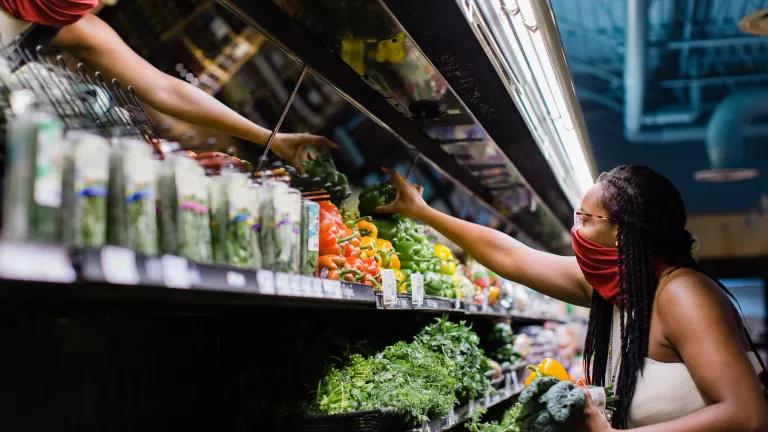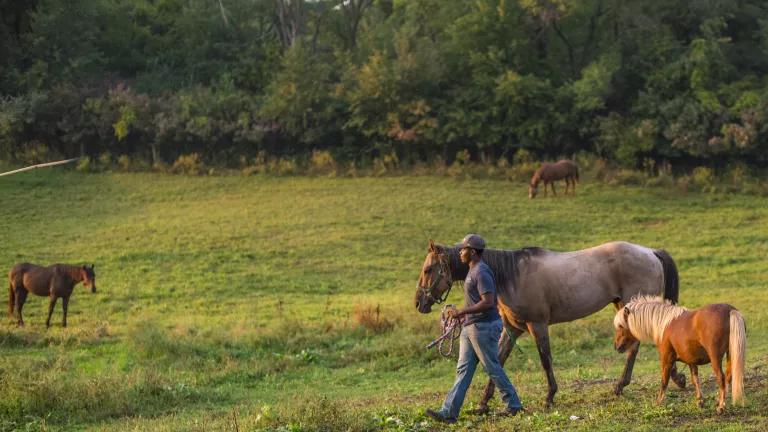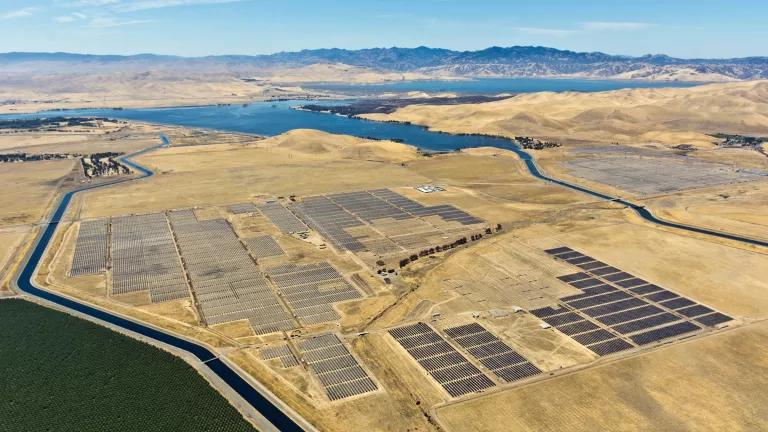COVID-19 Relief Package Must Recognize Food Is Fundamental

Little else matters when you can’t put food on the table. COVID-19 has laid bare both how quickly food insecurity can surge and how brittle our entire food system is to shocks and stressors. Any future relief package must address the crushing hunger facing too many families and must heal our crumbling food chains.
Hunger has soared as a result of COVID-19 and the economic crisis, with profound racial disparities and major impacts on children. Nearly four in ten Black and Latinx households with children cannot afford the food they need. In addition, many families are no longer able to shield their children from hunger, and child food insecurity rates have quadrupled as a result of the pandemic.
At the other end of the food chain, farmers, workers, and families face threats to their lives and livelihoods. The people who pick, process, and package our food are disproportionately infected with COVID-19. As of September 14, at least 59,041 food system workers (meatpacking workers, food processing workers, farmworkers) have tested positive, and at least 252 workers have died. At the same time, supply chain disruptions—including school and restaurant shutdowns—have forced farmers to dump food.
This is a crucial moment for federal leadership. Unfortunately, to date the Senate Majority’s proposals for COVID-19 relief are missing interventions that will feed hungry people and keep our food system working safely through this crisis: expansion of SNAP benefits and investments in regional food systems. Instead, the Senate Majority has proposed another blank check for USDA, along with blanket liability waivers that will leave the most vulnerable workers in the food system without recourse.
Build on What Works: Increase SNAP Benefits & Flexibility
SNAP is a powerful tool to stem the rise of hunger. Increasing SNAP benefits and flexibility would allow the program to better meet the needs of hungry families and could create markets for regional food producers.
More than 6 million people enrolled in SNAP in the first three months of the COVID-19 pandemic—bringing the total number of people served to 43 million. The program has proved uniquely effective at quickly meeting the needs of the newly unemployed.
However, despite a huge uptick in enrollment, many families continue to struggle with hunger—and worrying data shows many children are not getting enough to eat. Even for enrolled families, the maximum SNAP allotment is not enough. The maximum benefit of $1.86 per meal does not cover the cost of a meal in 99 percent of continental counties and Washington, DC.
Too often, SNAP recipients are not afforded the same purchasing flexibility as more affluent shoppers. New SNAP online shopping programs in many states have made it easier to buy food safely during the pandemic. However, in most states, these programs are limited to two major retailers. This makes it challenging for online SNAP shoppers to buy fresh, local food, support nearby farmers, and keep money in the local economy.
To address these issues, Congress must expand SNAP benefits and maximize opportunities for families to access food. The House’s HEROES Act (H.R. 6800) prioritizes critical measures to address hunger, including a 15% increase in SNAP’s maximum allotment and a modest raise to $30 in the minimum monthly benefit. In addition, the Expanding SNAP Options Act (S.4202/H.R.7535) would make it easier for millions of people to buy healthy fresh food from local producers. But the Senate Majority’s proposals have left out SNAP completely.
Keep the Food Chain Connected: Pass the Food Supply Protection Act
The food supply chain and the people who keep it running also need help to survive the COVID-19 crisis, and we can protect the environment at the same time. The Food Supply Protection Act (FSPA) is a good start: it would improve food bank infrastructure, create markets and distribution channels for surplus food, and help small and mid-sized food businesses protect their workers and respond to changing needs.
As food bank lines stretch for blocks, the FSPA would provide critical support for emergency food access. It would grant $1 billion to emergency food operations to store and distribute donated food products and build additional capacity. This would not only increase the amount of food available at a local level, it would also ensure less food goes to waste.
The FSPA would also support innovative partnerships that could reduce food waste. Many farmers—especially diversified farmers, direct to consumer farmers, and farmers of color—have been overlooked in COVID-19 aid programs. The FSPA would provide $1 billion in funding to state and tribal governments to increase local food procurement. It would also allow USDA to pay food producers to donate surplus food, to feed food insecure people and prevent food from going to waste. Innovative partnerships at the local level are already happening—FSPA would provide them much needed support and encourage new partnerships.
Finally, the FSPA would help small and mid-sized food producers make urgent changes to their businesses. The bill provides direct support for food producers currently left out of aid, and it would set aside 10% of grants specifically for beginning, veteran, and socially disadvantaged farmers, including farmers of color. It also includes investments to strengthen the safety and capacity of local and regional food systems. Regional food enterprises—including processors, distributors, markets, and emergency food sites—have been working nonstop with creativity and flexibility to feed their communities. They need help covering costs of protective gear for workers, equipment, and technology upgrades to keep getting food to families.
Blank Checks & Lack of Accountability Are Not the Answer
The Senate Majority’s first attempt at the next COVID-19 relief package ignored these fundamental needs. Instead of scaling up SNAP, investing in regional food systems, and providing assistance to small farmers, it would have handed $20 billion to USDA, to use as the agency saw fit. The bill included even less direction for spending than the CARES Act did; given the agency’s track record, that likely means it would have amounted to yet another handout to the largest and most powerful players in the food system. The latest Senate proposal was even worse—it completely left out USDA.
The next relief package must prioritize hunger and small- and mid-sized food producers who have lost direct markets. The Local Farmer Act (H.R.8096) marks an important step in that direction—it would direct relief to farmers and ranchers who serve local and regional markets, with funds and support designated specifically for Black, Indigenous, and other producers of color.
In addition, relief legislation must not undermine worker safety. The Senate Majority has proposed a sprawling liability shield that places business interests above essential workers; it has absolutely no place in a recovery bill and must be kept out of any agreement. Liability shield legislation would dismantle the legal rights of individuals who deserve greater protection; by allowing those who fail to provide safe environments for workers and the public to avoid responsibility, a liability shield would encourage dangerous actions that could set back our fragile recovery with a resurgence of infection. Appallingly, the liability shield proposals also use the pandemic to establishe vague, nebulous exemptions to the Occupational Safety and Health Act, the Fair Labor Standards Act, the Age Discrimination in Employment Act of 1967, the Genetic Information Nondiscrimination Act, the Americans with Disabilities Act and the Civil Rights Act of 1964.
Slaughterhouses provide a very clear example of how a liability shield would harm workers and public health. Workers at industrial meat facilities labor under notoriously dangerous, close, and unsanitary conditions where infections can spread rapidly. These operations have poor track records on workers’ rights even under normal conditions, and they are among the most infamous infection hot spots in the nation. Shielding these companies from liability for unsafe conditions all but guarantees high-risk actions that will promote infection and destabilize the nation’s food system.
Feed Families & Mend Our Food System—NOW
Congress has authorized nearly $3 trillion in COVID-19 relief spending to date, and will likely continue to spend more. It would take just a tiny fraction of those funds to put enough food on our tables, avoid unnecessary food waste, and ensure the safety, health, and survival of communities of color, low-income families, small farms, and essential workers. The cracks in our food system have been hidden for too long—it’s time for Congress to pay attention.





